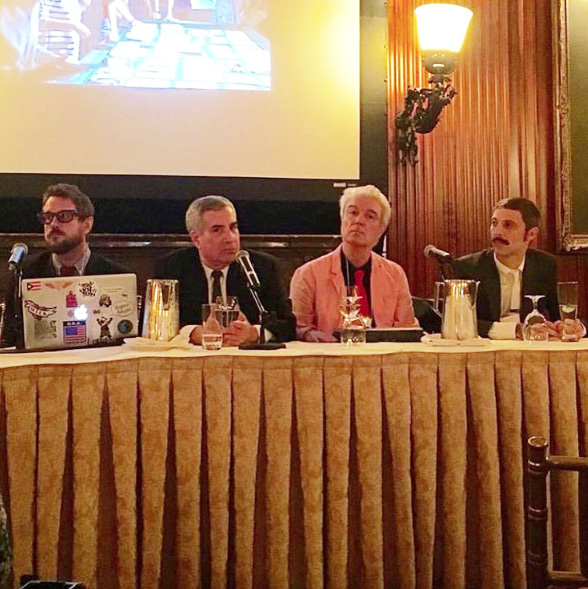NYC panel includes Talking Head on media preservation
By Jon Craig

A panel of art and archive experts stressed the importance of preserving materials in a digital age at a March 10 discussion at New York City’s University Club.
The discussion, sponsored by Cornell University Library, was titled “New Paths in Collecting Modern Cultural Material.” Each of the panelists, including Talking Heads founder and frontman David Byrne, creates or collects modern culture – from music to visual art to underground magazines and artist books.
Byrne shared voluminous raw music files he had archived, and other panelists featured poetry and artwork preserved after being mailed or photocopied in limited editions as part of underground zines.
“This is the best-organized artists’ archive I’ve ever seen,” said Johan Kugelberg, who moderated the discussion attended by more than 100 alumni, collectors and archivists.
Kugelberg, founder of the gallery and publishing house Boo-Hooray, has taught and lectured at Cornell and Yale universities and his gifts to the library’s Division of Rare and Manuscript Collections include the material that became the Cornell Hip Hop Collection.
Byrne explained his passion for and obsession with collecting obscure works of music – including floppy discs of English DJ and musician Norman Cook (aka Fatboy Slim), who meticulously saved snippets of drumbeats for mixing music.
“I just wanted to keep on top of it. It saves so much time. I started saving stuff pretty early,” Byrne said. “I tend to over-collect. I buy extensively to give myself time to reflect back.”
In addition to his prolific and wide-ranging career as a solo artist, Byrne has published and exhibited visual art including photography and films, and has written fiction and nonfiction.
Preserving and organizing past work also has an impact on his new material, Byrne said.
“It gets rejuvenated, reworked. It becomes fodder for whatever you’re doing. So as a working artist you want access to that stuff,” he said. “So, for me, I realized that it's not about the preciousness of the stuff I keep. It really has a utility, it really has a value for me as a working artist.”
In her introduction, Anne Kenney, the Carl A. Kroch University Librarian, said that preserving cultural material has been an important part of the library’s mission since Cornell’s founding.
“Physical, tangible objects make up our cultural heritage,” Kenney said. “Much of that legacy would not have survived, but for the foresight of generations of collectors, such as our panelists tonight.”
Phil Aarons, board president of Printed Matter, discussed rare printed works by poets Wallace Berman, Ray Johnson and others. After Berman’s arrest by Los Angeles Police in the 1960s, the poet’s son, Tosh, launched a mail campaign in which he sent other writers and artists updates and examples of his father’s poetry on postcards or written on the outside of envelopes.
Johnson, who was arrested repeatedly for obscenity, would send his poetry as a form of chain mail, asking the recipient to add a comment and forward it to another writer or artist. His underground legacy earned him the label “New York’s most famous unknown artist.”
“It was a big deal if you got a Ray Johnson letter. You would add to it and send it on,” Aarons said. “He built this large network.”
Lele Saveri, curator and founder of 8-Ball Zines and Muddguts Gallery in Brooklyn, talked about his efforts to preserve and document the Newsstand, an underground bookstore he created inside the Lorimer/Metropolitan MTA subway station, where artists could drop off their work for others to see and which became an installation at the Museum of Modern Art.
“I'm worried things will just go, so I take pictures, take pictures on film because I can attach the negative. I record sound, I record video. Everything that I do needs to be recorded because I worry it's not going to stay with me,” he said. “I didn’t know the MOMA was coming, but I thought I would care in 10 years to see what happened.”
During a question-and-answer period, panelists were asked if everything will be saved digitally 50 years from now.
“Every time there is a transition from one kind of technology to another, like oral culture to printed… something gets filtered out,” Byrne said. “There are things that get translated in oral cultures that you can’t communicate in written culture. Things that happen on physical paper don’t translate into digital… There’s definitely a loss every time there’s a transition.”
Jon Craig ’80 is a journalist based in Westchester County, New York.
Media Contact
Get Cornell news delivered right to your inbox.
Subscribe